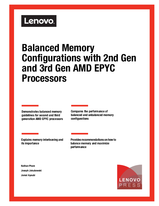Authors
Updated
26 Jun 2021Form Number
LP1268PDF size
22 pages, 287 KBAbstract
Configuring a server with balanced memory is important for maximizing its memory bandwidth and overall performance. Lenovo ThinkSystem servers running AMD EPYC processors have eight memory channels per processor and up to two DIMMs per channel, so it is important to understand what is considered a balanced configuration and what is not.
This paper defines three balanced memory guidelines that will guide you to select a balanced memory configuration. Balanced and unbalanced memory configurations are presented along with their relative measured memory bandwidths to show the effect of unbalanced memory. Suggestions are also provided on how to produce balanced memory configurations.
This paper provides performance-optimized memory configuration recommendations for different requirements based on the number of DIMMs per socket. Recommendations includes the 6-DIMM and 12-DIMM per socket configurations for third-generation AMD EPYC processors.
This paper is for customers and for business partners and sellers wishing to understand how to maximize the performance of Lenovo ThinkSystem servers with second-generation and third-generation AMD EPYC processors.
Table of Contents
Introduction
Memory topology
Memory interleaving
Balanced memory configurations
About the tests
Applying the balanced memory configuration guidelines
Summary of the performance results
Summary
To view the document, click the Download PDF button.
Change History
Changes in the June 26, 2021 update:
- Updated the paper to include AMD EPYC 7003 processors
Other Balanced Memory papers
This paper is one of a series of papers on Balanced Memory configurations:
Intel processor-based servers:
- Balanced Memory Configurations for 2-Socket Servers with Intel Xeon 6 Processors
- Balanced Memory Configurations for 2-Socket Servers with 4th and 5th Gen Intel Xeon Scalable Processors
- Balanced Memory Configurations for 2-Socket Servers with 3rd Gen Intel Xeon Scalable Processors
- Balanced Memory Configurations with 2nd Gen Intel Xeon Scalable Processors
- Balanced Memory Configurations with 1st Generation Intel Xeon Scalable Processors
- Maximizing System x and ThinkServer Performance with a Balanced Memory Configuration
AMD processor-based servers:
Configure and Buy
Full Change History
Course Detail
Employees Only Content
The content in this document with a is only visible to employees who are logged in. Logon using your Lenovo ITcode and password via Lenovo single-signon (SSO).
The author of the document has determined that this content is classified as Lenovo Internal and should not be normally be made available to people who are not employees or contractors. This includes partners, customers, and competitors. The reasons may vary and you should reach out to the authors of the document for clarification, if needed. Be cautious about sharing this content with others as it may contain sensitive information.
Any visitor to the Lenovo Press web site who is not logged on will not be able to see this employee-only content. This content is excluded from search engine indexes and will not appear in any search results.
For all users, including logged-in employees, this employee-only content does not appear in the PDF version of this document.
This functionality is cookie based. The web site will normally remember your login state between browser sessions, however, if you clear cookies at the end of a session or work in an Incognito/Private browser window, then you will need to log in each time.
If you have any questions about this feature of the Lenovo Press web, please email David Watts at dwatts@lenovo.com.

